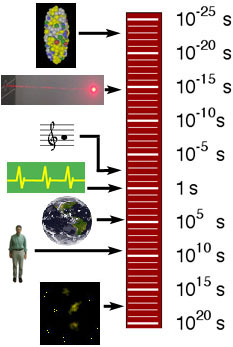Time
 There
are about 40 orders of magnitude between the
radius of the Universe and the radius of the proton. Interestingly,
there are also about 40 orders of magnitude between the age of the
universe and the lifetime of the shortest-lived elementary particles.
Here is an overview of the different time scales:
There
are about 40 orders of magnitude between the
radius of the Universe and the radius of the proton. Interestingly,
there are also about 40 orders of magnitude between the age of the
universe and the lifetime of the shortest-lived elementary particles.
Here is an overview of the different time scales:
- The typical duration of high-energy nuclear collisions and
also the lifetime of the shortest-lived elementary particles is
about 10-23 s. This is also the time it takes a beam of
light to cross the diameter of a proton.
- Visible light waves oscillate about once every
2$\cdot$ 10-15 s.
- The radiowaves that an AM station emits have an oscillation
period of 10-6 s.
- Pressure waves in the sound of the medium A musical note have
a period of 2.3$\cdot$ 10-3 s.
- The human heart beats about once per second.
- An hour has 3600 seconds and a day therefore 24$\cdot$ 3600 = 86400
seconds. The period with which the Earth rotates is not exactly
this time interval, but slightly less, 86160 seconds.
- A year has 365.25 days (Remember that every 4th year is a leap
year with 366 days!), about 31 557 600 seconds.
- The mean life time of a human currently is about 75 years, or
about 2.4$\cdot$ 109 seconds.
- Human civilizations have existed for about
5$\cdot$ 1011 s on Earth.
- Dinosaurs have been extinct for about 1015 s. (News
flash for all of you literal creationists: this time interval is
much longer than the approximately 6 to 15 thousand years that
creation "science" claims the Earth has been in existence.
Instead, the Earth's age is about 4-5 Billion years, about
1.5$\cdot$ 1017 s.
- The newest astronomical measurements place the age of the
Universe at between 12 and 14 Billion years, about
4$\cdot$ 1017 s.
© MultiMedia Physics, 1999
 There
are about 40 orders of magnitude between the
radius of the Universe and the radius of the proton. Interestingly,
there are also about 40 orders of magnitude between the age of the
universe and the lifetime of the shortest-lived elementary particles.
Here is an overview of the different time scales:
There
are about 40 orders of magnitude between the
radius of the Universe and the radius of the proton. Interestingly,
there are also about 40 orders of magnitude between the age of the
universe and the lifetime of the shortest-lived elementary particles.
Here is an overview of the different time scales: